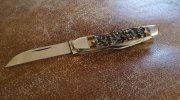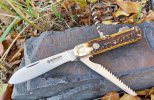To answer the OP’s question, I pay attention to blade steel.
The first knife I bought was a Case stockman, I never was really happy with the edge holding of it, What that knife taught me was to never buy a single blade knife, pun intended one blade would not cut it for a days work. Stockmans ruled.
After that Case I tried Buck, Old Timer, Camillus. I had steels categorized, Stainless was good for hunting and fishing. For a work knife 1095 would hold an edge better.
At the time I didn’t know anything about steel, I just had my own experiences to go on.
Bladeforums has taught me a lot about steel and that has opened up a whole new world of knife patterns. I’ve got a D2 single blade barlow in my pocket as I type this. One blade, two blades, it doesn’t have to be a stockman anymore.
I still like and carry 1095 but I always back it up with a stainless like the Indian River Jack.
I prefer steels like 440C, 154CM, CPM 154. With D2 being a favorite partly because it’s easier to find in a traditional and partly because I never have to sharpen it half way through the day.
I’ve learned all steel is easy to sharpen, some steels are just harder to profile.
Over the years I’ve learned what I like in a knife, size, weight, pattern, blade shape. There’s a lot of boxes to check before I buy. Steel is one of those boxes.
I have a rule when it comes to buying a knife, If the maker doesn’t state the steel and hardness I won’t even look at it. Terms like CV, Tru-Sharp, surgical stainless, high carbon stainless etc are not the name of steels.
The first knife I bought was a Case stockman, I never was really happy with the edge holding of it, What that knife taught me was to never buy a single blade knife, pun intended one blade would not cut it for a days work. Stockmans ruled.
After that Case I tried Buck, Old Timer, Camillus. I had steels categorized, Stainless was good for hunting and fishing. For a work knife 1095 would hold an edge better.
At the time I didn’t know anything about steel, I just had my own experiences to go on.
Bladeforums has taught me a lot about steel and that has opened up a whole new world of knife patterns. I’ve got a D2 single blade barlow in my pocket as I type this. One blade, two blades, it doesn’t have to be a stockman anymore.
I still like and carry 1095 but I always back it up with a stainless like the Indian River Jack.
I prefer steels like 440C, 154CM, CPM 154. With D2 being a favorite partly because it’s easier to find in a traditional and partly because I never have to sharpen it half way through the day.
I’ve learned all steel is easy to sharpen, some steels are just harder to profile.
Over the years I’ve learned what I like in a knife, size, weight, pattern, blade shape. There’s a lot of boxes to check before I buy. Steel is one of those boxes.
I have a rule when it comes to buying a knife, If the maker doesn’t state the steel and hardness I won’t even look at it. Terms like CV, Tru-Sharp, surgical stainless, high carbon stainless etc are not the name of steels.



